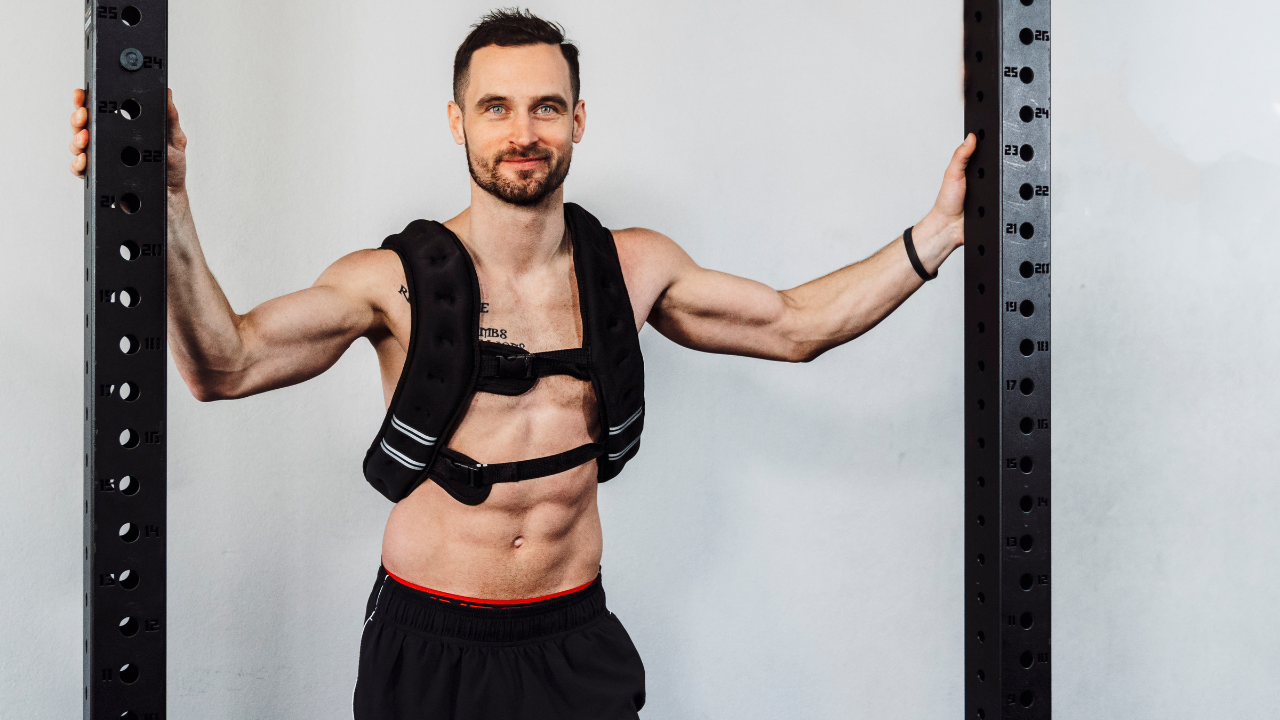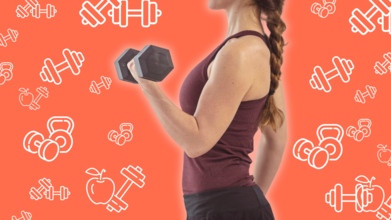- Health Conditions A-Z
- Health & Wellness
- Nutrition
- Fitness
- Health News
- Ayurveda
- Videos
- Medicine A-Z
- Parenting
- Web Stories
Winter Workouts: How To Stay Energized, Safe And Healthy In The Cold

Image Credit: Canva
As winter settles in, the temptation to hibernate can be strong, but that doesn't mean you need to abandon your fitness routine. In fact, working out in the winter offers unique benefits that can enhance both your physical and mental well-being. By embracing the cold and venturing outdoors for winter workouts, you can enjoy a refreshing, energy-boosting routine that helps keep you on track during the chilly months.
Benefits of Exercising in Winter
Winter workouts have the power to combat seasonal affective disorder (SAD) and lift your spirits. Exposure to natural light, even on cloudy days, can help regulate your circadian rhythm, boosting your mood and improving sleep quality. The endorphins released during physical activity can act as natural mood boosters, leaving you feeling energized and positive throughout the day.
Aside from improving mental health, winter workouts are a great way to stay fit and maintain your strength. Engaging in outdoor activities like brisk walking, snowshoeing, and cross-country skiing offers a full-body workout that challenges your cardiovascular endurance and strengthens your muscles. You’re likely to burn more calories in the cold due to your body’s efforts to stay warm, giving you an added fitness boost.
Layering Up
When working out in the winter, it’s essential to dress appropriately. Layering your clothing is key to regulating your body temperature and staying comfortable. Start with a moisture-wicking base layer that draws sweat away from your skin, keeping you dry and warm. Follow this with an insulating mid-layer, which will provide warmth without causing you to overheat. Finally, top it off with a waterproof outer layer to shield you from wind, rain, or snow. This combination will ensure you're protected from the elements while maintaining optimal body temperature.Stay Dry, Stay Warm
In winter, damp clothing can quickly lead to hypothermia since moisture draws heat away from your body. Choose fabrics that wick moisture away, like merino wool or synthetic blends. This will help you stay dry and insulated throughout your workout. Keeping your skin dry is essential to prevent body heat loss, especially if you’re planning to be outdoors for an extended period.Protecting Your Extremities
When it comes to winter fitness, the extremities are often the most vulnerable. Your hands, feet, ears, and nose are prone to cold, so it’s important to shield them. Wear thermal gloves, warm socks, and a hat to protect your head and ears. Also, don’t forget about your face: a scarf or face mask can help shield your face from biting winds, ensuring you stay comfortable and protected throughout your workout.Prioritize Safety
Winter days are shorter, and it can be difficult to see and be seen, especially during early morning or late evening workouts. Wear brightly colored or reflective clothing to improve your visibility to others. This simple precaution can significantly reduce the risk of accidents when exercising outdoors in low-light conditions.Additionally, icy surfaces pose a significant slip hazard. Invest in footwear with good traction or use ice cleats for better grip, especially if you plan on running, walking, or hiking on snowy paths. These small investments can make a big difference in preventing falls and injuries during your outdoor fitness routine.
Two Essential Winter Fitness Tips
Hydration
Though the cold weather may reduce your thirst, staying hydrated remains crucial. Cold air can dehydrate you just as easily as warm temperatures, leading to fatigue, headaches, and poor performance. Drink plenty of water throughout the day to keep your body functioning optimally.Sun Protection
Another often-overlooked aspect of winter workouts is sun protection. UV rays can still cause skin damage, even in winter months. Snow can reflect UV rays, intensifying the exposure. Use a broad-spectrum sunscreen with a high SPF on any exposed skin, especially your face, ears, and neck, to protect against harmful radiation.How Warming Up and Cooling Down are Essential for Winter Workouts?
When preparing for a winter workout, a dynamic warm-up is key. Stretching and performing exercises like arm circles, leg swings, and torso twists helps increase blood flow, improve flexibility, and reduce the risk of injury. Given the colder weather, your muscles may take a little longer to warm up, so be sure to take your time during your warm-up routine.
After your workout, don’t forget to cool down. Gradually reduce your intensity and perform static stretches to ease muscle tension and prevent soreness. A proper cool-down will help your body recover, reduce stiffness, and improve flexibility.
Breathing cold air during intense activity can irritate your airways, leading to discomfort. To avoid this, focus on slow, deep breaths. This technique warms the air before it enters your lungs, reducing irritation and allowing you to breathe more comfortably. If the cold is particularly harsh, consider wearing a scarf or face mask to warm the air and protect your respiratory system.
Exercising in winter doesn’t have to be a struggle or a chore. Winter workouts offer numerous benefits, including enhanced mood, improved physical health, and better sleep. Plus, they help you break free from the winter blues, keeping your fitness goals on track throughout the season.
Winter is the perfect opportunity to explore new outdoor activities, challenge yourself in different ways, and embrace the cold in a healthy and empowering way.
How Much And How Fast Do You Need To Walk For Your Heart Health? Shorter Walks Also Help

(Credit - Canva)
Walking is one of the best exercises we do. Not only is it cost effective, it needs minimal gear and has many health benefits. Walking for heart health is a great idea and has been shown to be very effective. However, there has been some discourse surrounding how many steps you need and how you should walk for maximum benefits.
We have seen the rise of walking trends like Japanese walking, 6-6-6 walking, backward walk etc. However, walking for health benefits doesn’t always have to be an elaborate affair. All you need is to make sure you are walking a certain amount of steps at a certain speed.
A new study suggests that you don't need to walk the often-recommended 10,000 steps to make a difference. The research found that even walking fewer steps each day—and picking up the pace a bit—can significantly lower your risk of major heart problems. The study is one of the first to show a clear link between the number of steps you take and the risk of heart and blood vessel issues.
How Many Steps Do You Need For Heart Health?
The study followed over 36,000 older adults with high blood pressure. Each participant wore a device for a week to track how far and fast they walked. Over an eight-year period, the researchers recorded nearly 2,000 heart problems or stroke incidents.
The findings, published in the European Journal of Preventive Cardiology, showed a clear link between daily steps and a lower risk of heart problems.
Every 1,000 steps added per day (starting from 2,300 steps) was linked to a significant drop in risk. This included a 17% reduction in overall heart risks, a 22% drop in heart failure risk, a 9% reduction in heart attack risk, and a 24% lower risk of stroke.
More is still better. While the benefits started at low step counts, they continued to increase with more steps, though not always at the same rate.
Walking faster helps. Participants who walked at a brisk pace of 80 steps per minute for 30 minutes a day had a 30% lower risk of a major heart problem. Those who walked even faster (130 steps per minute) had no major heart events at all. Similar benefits were also found in people who did not have high blood pressure.
Why Walking Is So Good for Your Heart
Walking is a simple yet powerful exercise that improves your health in many ways.
It strengthens your heart
Regular walking makes your heart stronger and better at pumping blood. Your blood vessels also become healthier, which helps your heart work more efficiently.
It improves your blood markers
Walking can help lower cholesterol, blood sugar, and a type of fat in your blood called triglycerides. It also helps reduce inflammation in your body.
Brisk walking boosts the benefits
Walking at a faster pace makes your heart and lungs work harder, which further improves your fitness, lowers blood pressure, and helps with weight management.
While the goal is to walk as much as you can, even small actions can add up. Here are some simple ways to fit more walking into your daily life:
- Swap short car trips for a walk.
- Take your dog for an extra walk and try to increase your pace at times.
- Park a little farther away from your destination.
- Choose the stairs over the elevator and take them a bit faster than usual.
- Walk around the house while you're on a phone call.
Do Weighted Vests Really Help With Weight Loss And Bone Health? Research Shows Mixed Results

(Credit-Canva)
Weighted vests have become a huge trend in the fitness world. You see celebrities wearing them, and they are all over social media. Many people wear them hoping to lose weight, build muscle, and even improve their bone strength, as what’s better than making these activities more of a challenge. These vests are especially popular with older women who want to protect their bones, which can become weaker after menopause.
But does science actually support all the social media hype? The answer is a bit complicated. The benefits might not be as clear-cut as a marketing suggests, and a new study is adding to the discussion.
Do Weighted Vests Improve Bone Health?
The evidence on this is mixed. A recent study, published in the journal JAMA Network Open, looked at 150 obese adults. The researchers had one group wear a weighted vest for seven hours a day for a whole year. The result? The vests did not reduce the amount of bone loss in their hips.
This finding was a surprise to many, especially since earlier research seemed to show the opposite. In fact, studies from the 1990s and 2000s suggested that weighted vests could help increase bone density and lower the risk of falls. More recently, a 2013 study found that postmenopausal women who exercised in a weighted vest for six weeks saw an increase in their bone density. Similarly, a 2015 study found that weighted vests helped postmenopausal women strengthen their leg muscles and improve bone density in their thigh bone.
One possible reason for the different results is the way the studies were done. In the newer study, participants started with very light vests, which may not have been enough to stimulate bone growth. Experts agree that more research is needed to fully understand the effects of weighted vests on bone health.

Can Weighted Vests Help with Weight Loss?
Research on whether weighted vests help with weight loss is limited, but some studies show a potential link. Still, other research points to a potential link. For example, a 2020 study found that people who wore a heavier weighted vest for eight hours a day over three weeks lost more body fat than those who wore a lighter vest. Another small study from 2025 suggested that wearing a weighted vest along with a calorie-restricted diet could help people avoid gaining back weight they had lost.
In the Wake Forest study, participants who wore weighted vests did lose about 10% of their body weight, but so did the other groups in the study who did not wear vests, suggesting the weight loss was likely from calorie cutting.
While the evidence isn't conclusive, it seems that weighted vests might be a helpful tool for some people on their weight loss journey, but they are not a magic solution on their own.
Should You Wear a Weighted Vest?
The science is still developing, but weighted vests may be a useful tool for some people. Experts say they could be particularly beneficial for postmenopausal women and anyone looking to make their resistance workouts more challenging.
If you decide to try a weighted vest, it's a good idea to keep the weight at or below 10% of your body weight. Always listen to your body and adjust your workout as needed.
Is Lifting Weights Everyday A Smart Workout Routine? We Weigh The Pros And Cons

Credits: Health and me
When one imagines becoming fit, weightlifting is usually the first to come to mind. It guarantees muscle development, a gain in strength, and a lean body. However, here's the catch—though strength training is not negotiable, determining the frequency is a different story altogether. Some gym-goers insist on a daily lift, while others caution it may do more harm than good.
Strength training has moved from mainstream to mass, and with that comes a new controversy: Should you lift every day? For some, daily resistance training is the shortcut to improvement. For others, it's a red flag about getting injured, overtraining, and burnout. To get clear, let's cut through what science has to say about the pros, the cons, and the balance between consistency and recovery.
Weight lifting isn't all about "chiselling" muscle. It's one of the best ways to exercise for long-term health. Two sessions of resistance training per week, at least, is suggested by the American College of Sports Medicine (ACSM), but fewer than 20% of American women reach that goal. This shortfall is important because resistance training accomplishes more than the development of strength it affects every system in the body.
The science isn't one-size-fits-all, either. Your recovery capacity, workout intensity, age, and even sleep habits can determine whether daily lifting assists or hinders you. What may work for an advanced lifter could blow up a beginner.
So before we take apart the effects on body composition and weight control, it's a fair question: Does weightlifting every day optimize gains—or does it burn you out?
Body Composition and Weight Control
Perhaps the largest benefit of weight training is its impact on body composition. The more muscle, the higher your resting metabolic rate; your body burns more calories even at rest. Science demonstrates resistance training is lowering visceral fat and preserving lean mass, both of which are protective of chronic disease. Unlike fad diets, these are sustainable.
Muscle and Strength Gains
It may seem glib, but lifting weights actually makes you stronger—and that strength is not just gym pride. It carries over into daily life, from lugging groceries to keeping up with the kids. Keeping muscle also becomes more critical as we get older. Without ongoing strength training, adults can lose 3–8% of muscle mass every decade after age 30, which makes lifting one of the most useful weapons against healthy aging.
Metabolic and Bone Health
Stronger muscles equal better metabolic health. Lifting weights improves insulin sensitivity and helps regulate blood sugar, reducing the risk of type 2 diabetes. For bones, the evidence is equally compelling. A decade-long study in Journal of Bone and Mineral Research Plus showed older adults who maintained resistance training not only preserved but actually improved bone strength, protecting against osteoporosis and fractures.
Brain and Mental Health
Mind-body connection exists. Endorphins are increased, anxiety reduced, and cognitive abilities such as memory and concentration improved with strength training. It even reduces risk of depression, studies indicate. Lifting weights is hence a potent tool for mental health as well, in addition to its physical benefits.
Is Lifting Weights Every Day Too Much?
That's where the argument gets fascinating. Consistency in exercise is important, but with weight training, recovery and rest come into the picture. Muscles build and adapt in resting periods, not during lifting alone.
Training the same muscle groups every day, particularly with high intensity, can boomerang. Overtraining will result in:
- Chronic soreness and muscle fatigue
- Higher risk of injuries
- Insomnia and mood swings
- Impaired immune function
In women, it might even lead to menstruation irregularities. In athletes, it usually leads to plateaued or worsened performance.
Why Is Recovery Part For Progress?
Rest isn't loafing—it's planning. Ligaments, tendons, and joints require time to recover, just like muscles. Avoiding rest days puts you at greater risk of overuse injuries that can take weeks or months to recover from. The sweet spot, in the opinion of the CDC and World Health Organization, is a minimum of two strength-training sessions per week, with recovery or light activity days in between.
When Daily Weight Training Can Work?
All "every day" routines aren't created equal. So long as intensity and volume are handled intelligently, daily sessions can be safe and even favorable.
Lighter Days Matter
Rather than seven consecutive heavy sessions, most lifters employ "active recovery" days. That might be resistance band exercises, bodyweight mobility drills, or stability training for the core. These still engage muscles but not to the point of debilitating them.
Another plan is programming. A split like a bodybuilder's—one day upper, one day lower—provides individual muscles more recovery while making the routine daily. But without proper planning, the cumulative fatigue is still there.
Who Should Be Careful?
Although strength training is safe for the majority, there are some groups for whom medical clearance is necessary prior to beginning: those with heart disease, joint problems, or who are pregnant. Older adults might be better off using weight machines than free weights if balance is an issue. It's invaluable for newbies to hire a trainer to learn proper form.
Tips If You Want to Lift Daily
If you find yourself drawn to the possibility of lifting every day, remember these guidelines:
Begin light and progress gradually: Start with bodyweight exercises such as squats or push-ups before adding weight.
Form comes first: Faultless technique avoids injury and guarantees gains.
Schedule recovery: Incorporate mobility work, stretching, and lower resistance training sessions to offset intense training.
Pay attention to your body: Fatigue, pain, and irritability are indicators you require more rest.
Lifting weights is probably the best thing you can do for your health, but more isn't necessarily better. For most of us, two to four sessions a week strike the optimal balance between strength gains, metabolic benefits, and prevention of injury. If you're dead set on lifting every day, mix up the intensity, include active recovery time, and don't train identical muscle groups consecutively.
Everyday activity is a wonderful goal—but weightlifting seven days a week is not a requirement for it. Balance, not excess, is the key to lasting improvement.
Disclaimer: The information contained in this article is for informational purposes only and should not be construed as medical advice. Consult with a health provider before initiating or altering your exercise routine.
© 2024 Bennett, Coleman & Company Limited



